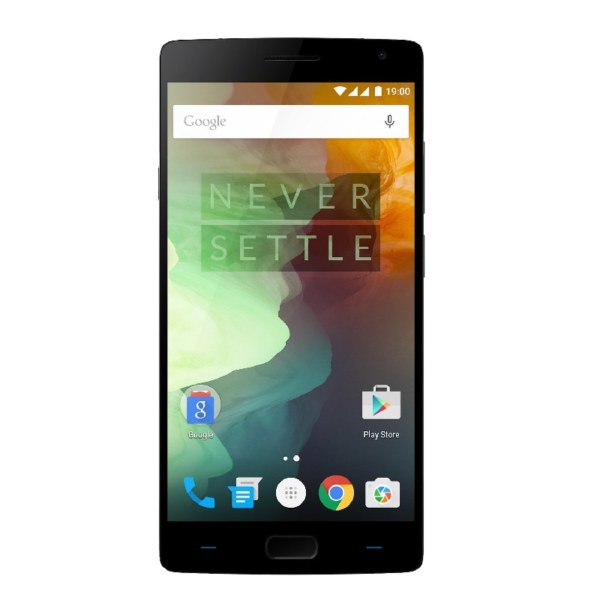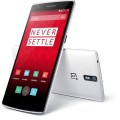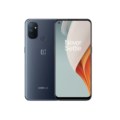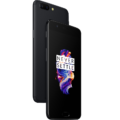- Home
- List of devices
- OnePlus
- OnePlus Two
OnePlus Two


-
CPU:
-
RAM:
-
Storage:
-
Display:
-
Camera:
-
OS:
OnePlus, a global technology startup, today announced its latest flagship product, the much anticipated OnePlus 2. Following the global success of last year’s OnePlus One, the latest offering reaffirms OnePlus’ commitment to the highest level of craftsmanship in the industry today. The OnePlus 2 boasts top of the line specs, one of the best cameras on the market, beautiful design and the adoption of state of the art technology.
“From day one, we’ve prioritized our product and our community above all else – we carefully listened to our users’ feedback and incorporated suggestions in building the OnePlus 2.” said OnePlus Founder and CEO, Pete Lau. “We chose premium materials, the highest performing components and forward thinking technology to make this an unparalleled user experience.”
Specs that Impress
The OnePlus 2’s aluminum-magnesium alloy frame and jewelry-grade stainless steel accents encase a vibrant, full HD 5.5” IPS LCD In-Cell display. The OnePlus 2’s display outperforms in direct sunlight with 178 degrees of crystal clear viewing angles. Noticeably more solid and durable, at just 175 grams, the OnePlus 2 is easy and natural to hold. A 3300mAh lithium polymer battery powers the device throughout the day, and as a dual-sim device the OnePlus 2 simultaneously supports two Nano SIM cards with 4G LTE capability.
The 64-bit Qualcomm® Snapdragon™ 810 SoC is the fastest processor on the market. With up to 64GB of storage and eMMC 5.0 flash memory, the OnePlus 2 is lightning quick. Paired with up to 4GB of LPDDR4 RAM, the OnePlus 2 powers all your apps, games and videos.
Capture Your World
The OnePlus 2 puts extraordinary digital photography power right in your pocket. The 13 megapixel rear facing camera boasts 6 physical lenses, powerful dual LED flash, and f/2.0 aperture. Perhaps most impressive is the sensor, which contains large 1.3µm light-collecting pixels to deliver low-light shots like you haven’t seen before.
The OnePlus 2 camera has been engineered for improved clarity and stability, accomplished with the addition of an advanced Optical Image Stabilization system. Rear mounted laser technology sharpens and focuses the camera in just .33 milliseconds and the wide-angle 5 megapixel front-facing camera ensures every angle is covered.
Carefully Crafted
The OnePlus 2 is a continuation of the smooth curves and clean lines that defined the OnePlus One. A striking yet subtle floating display and metal chamfered edges add elegance and solidity to the outer frame, also making the OnePlus 2 easy to hold and comfortable in the hand.
In addition to OnePlus’ signature Sandstone Black, consumers now have access to a range of covers including actual wood built Bamboo, Black Apricot, Rosewood and even Kevlar.
Ahead of the Curve
Equipped with a USB Type-C charging port, OnePlus is paving the way for the adoption of USB Type-C technology, the latest in charging and data transfer. Taking it one step further, the OnePlus charging cable uses patented technology making the Type-A side reversible as well.
The OnePlus 2 is equipped with a fingerprint scanner, adding premium security and convenience. Users can now wake and unlock the device with one of five stored fingerprints in less than half a second. Additionally, the OnePlus 2 features an alert slider for quick access to custom notification settings. Unprecedented on an Android device, the alert slider can silence the device with a simple click.
Innovative operating system – OxygenOS
The OnePlus 2 is the first device in the world to ship with OnePlus’ own operating system, OxygenOS. “With the OnePlus 2, we’re making a bet on the future, and doubling down on a holistic product experience,” said OnePlus Co-founder, Carl Pei. “We’re excited for what our fans have to say.”
OxygenOS, based on Android 5.1, is a refreshing take on the pure Android experience. Subtle customizations like on screen gestures, dark mode, the ability to switch between hardware and capacitive buttons and toggle quick settings are baked in throughout the OS. Loaded with custom apps including Camera, Audio Tuner and File Manager, OxygenOS delivers a light, secure take on Android.LTE band 1(2100), 3(1800), 5(850), 7(2600), 8(900), 20(800), 38(2600), 40(2300), 41(2500)
Specs
General
| Announced | 01 July, 2015 |
| Released | 01 August, 2015 |
| Status | Available |
Display
| Display Type <strong>Display Technology => </strong> A number of display technologies and types used in mobile phones => TFT (Thin Film Transistor), IPS (In-Place Switching), OLED (Organic Light Emitting Diode), AMOLED (Active-Matrix Organic Light-Emitting Diode), Super AMOLED (an even advanced version of AMOLED), Resistive Touchscreen (Resistive touchscreens contain two layer of conductive material with a very small gap between them which acts as a resistance), Capacitive Touchsceen (Capacitive touchscreen technology consists of a layer of glass coated with a transparent conductor) | In-Cell LCD |
| Size | 5.5 |
| Resolution | 1080 x 1920 |
| Pixel Density <strong>Pixel Density (PPI)</strong> is refers to the concentration of pixels on a particular display, measured in pixels per inch (ppi). Pixel density is calculated by dividing the diagonal pixel resolution of a display by its diagonal size, higher pixel density better display quality. | 401 ppi |
| Display Protection <strong>Display Protection => </strong> Gorilla Glass is a special alkali-aluminosilicate glass shield with exceptional damage resistance that helps protect mobile displays from scratches, drops, and bumps of everyday use, It is always better to go for a smartphone with Gorilla Glass for that added protection and peace of mind. | Corning Gorilla Glass 3 |
| Secondary Display | None |
Hardware
| Chipset <strong>Chipset</strong> is a group of integrated circuits designed to perform one or a more dedicated functions, often with real time computing constraints, Popular smartphones are equipped with more advanced embedded chipsets that can do many different tasks depending on their programming. | 4-bit Qualcomm© Snapdragon™ 810 processor |
| CPU <strong>CPU</strong> (Central Processing Unit) mostly known as processors, CPU processes instructions in order to carry out certain functions that make your device operate properly. Processors are often described as the brain of computers, smartphones and tablets, Smartphones and tablets rely on processors to carry out their every task, Processors are an incredibly important factor in selecting any type of computing device, including your smartphone. | 4x 1.56 GHz Cortex A53 + 4x 1.82 GHz Cortex A57 |
| GPU <strong>GPU</strong> (Graphics Processing Unit) is a single-chip processor designed to rapidly manipulate and alter memory to accelerate the creation of images in a frame buffer intended for output to a display, This includes things such as lighting effects, object transformations, and 3D motion. | Adreno 430 |
| RAM (Memory) <strong>RAM</strong> (Random Access Memory) is a type of computer memory that can be accessed randomly, any byte of memory can be accessed without touching the preceding bytes that allows information to be stored and accessed quickly from random locations. RAM is the most common type of memory found in computer systems, smartphones, tablets and other electronic devices. | 3GB / 4GB |
| Internal Storage <strong>Internal Storage</strong> is a data storage space (flash memory) mostly used in smartphones, tablets and other electronic devices where operating system, apps, music, photos, videos, files and other user data Is stored. | 16/64GB |
| Card Slot <strong>Memory Card Slot</strong> is a special slot for inserting a memory card. Memory cards allow you to expand the phone's built-in memory, A memory card (sometimes called a flash memory card or a storage card) is a small storage medium used to store data such as text, pictures, audio, and video, for use on small, portable or remote computing devices such as mobile phones, mp3 players, digital cameras. | No |
| Sensors <strong>Sensors</strong> are electronic components that detects and responds to some type of input from the physical environment. The specific input could be light, heat, motion, moisture, pressure and location, The output is generally a signal that is converted to use in computing systems, a location sensor, such as a GPS receiver is able to detect current location of your electronic device. | Fingerprint, Accelerometer, Gyroscope, Proximity and Ambient Light |
Battery
| Battery Type <strong>Battery Type => </strong> Cell phones run on various kinds of batteries depending on the manufacturer, phone size or shape and features. There are basically four types of cell phone batteries => Lithium Polymer, Lithium Ion, Nickel Metal Hydride and Nickel Cadmium. | Li-Poly (Lithium Polymer) |
| Capacity <strong>Battery Capacity</strong> is a measure (typically in Amp-hr) of the charge stored by the battery, and is determined by the mass of active material contained in the battery. The battery capacity represents the maximum amount of energy that can be extracted from the battery under certain conditions. | 3000mAh |
Camera
| Primary <strong>Camera</strong> is able to capture photographs and usually videos, The most important characteristics of a camera are the resolution (measured in megapixels), lens focus type (fixed or automatic), higher megapixel cameras are known to capture higher quality photos, but not always a good measurement of the photos quality. | 13mp |
| Camera Features |
6-element lens f/2.0 aperture |
| Secondary | 5mp |
| Video | Up to 4K resolution |
| Flash <strong>Flash Light => </strong> There is commonly two types of flash lights are used in camera mobile phones, LED Flash (LED flash offers lower power consumption with drive circuitry that takes up very little room, LEDs can be strobed faster than any other light source), Xenon Flash (xenon flash produces an extremely intense full-spectrum white light for a very short duration) | Dual LED |
Design
| Type <strong>Design Type</strong> called form factor refers to a mobile phone's size, shape, and style as well as the layout and position of major components of phone. There are three major form factors seen in mobile phones => bar phones, folding phones and sliding phones. | Bar |
| Dimensions | 151.8 x 74.9 x 9.85 mm |
| Weight | 175 grams |
| Protection | Gorilla Glass 4 |
| Colors | Sandstone Black |
Network
| SIM <strong>SIM</strong> (Subscriber Identity Module) is a small card that contains mobile network subscriber's account information. This allows the phone using the card to attach to a mobile network. The SIM card is most commonly associated with GSM and UMTS mobile networks. Moving a SIM card from one phone to another allows a subscriber to switch mobile phones without having to contact their mobile network carrier. SIM cards can also be used by a phone to store limited amounts of data, such as phone numbers and text messages. | Standard SIM |
| 2G Network | GSM: 850, 900, 1800, 1900 MHz |
| 3G Network | HSDPA 850 / 900 / 1900 / 2100 |
Software
| Operating System <strong>OS => </strong> Every computer system run on a base software called Operating System (OS). Operating System controls all basic operations of the computer (such as smartphone, PDAs, tablet computers and other handheld devices). The Operating System allows the user to install and run third party applications (apps), apps are used to add new functionality to the device. | Android 5.1.1 Lollipop |
| User Interface <strong>UI</strong> or user interface of a device is the look and feel of the on-screen menu system. How it works, its color scheme, how it responds to button presses, all of these things are part of the user interface. | Oxygen UI |
Connectivity
| Bluetooth <strong>Bluetooth</strong> is a wireless communications technology for exchanging data between mobile phones, headsets, computers and other network devices over short distances without wires, Bluetooth technology was primarily designed to support simple wireless networking of personal consumer devices. | v4.1 |
| Infrared <strong>Infrared</strong> connectivity is an old wireless technology used to connect two electronic devices. It uses a beam of infrared light to transmit information and so requires direct line of sight and operates only at close range. | |
| Wi-fi <strong>Wi-Fi</strong> is a popular wireless networking technology using radio waves to provide high-speed network connections that allows devices to communicate without cords or cables, Wi-Fi is increasingly becoming the preferred mode of internet connectivity all over the world. | 802.11 b/g/n/ac |
| USB | 2.0 |
| GPS <strong>GPS</strong> The Global Positioning System is a satellite-based radio navigation system, GPS permits users to determine their position, velocity and the time 24 hours a day, in all weather, anywhere in the world, In order to locate your position, your device or GPS receiver must have a clear view of the sky. | Yes |
| NFC <strong>NFC</strong> (Near field communication) is a set of standards for smartphones and similar devices to establish peer-to-peer radio communications with each other by touching them together or bringing them into proximity, usually no more than a few inches. |



